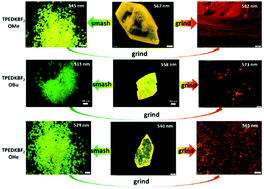The inherent mechanism of mechanochromism under different stress: electron cloud density distribution, J-type stacking, pore structure and collapse of J-type stacking†
Abstract
Mechanochromic materials usually exhibit different mechanochromic behaviour after being ground, smashed and exposed to ultrasound, however, the inherent mechanisms of these different mechanical stresses have remained elusive until now. In order to unveil the critical factors of mechanochromism, five TPE unit containing difluoroboron beta-diketonate complexes with different alkyl chain lengths were synthesized. The results indicate that the complexes show strong solid state fluorescence emission, remarkable AIE properties and multicolor switching. However, the complexes exhibited irregular mechanochromic behavior upon an increase in the alkyl chain length. Upon grinding, the complexes exhibited red-shifted solid state fluorescence emission, and the degree of the red-shift can be mainly attributed to the initial crystalline emission, which depends on the J-type molecular stacking and electron cloud density distribution. In contrast to what was observed after grinding, ultrasonic treatment and smashing led to a blue-shift in the solid state fluorescence emission, and furthermore, with the former being observed to have a better mechanochromic effect than the latter. Based on detailed crystal analysis, the complexes were found to have a similar J-type stacking but different pore structure or head-to-head stacking, which leads to obvious wavelength shift for TPEDKBF2OMe, TPEDKBF2OBu and TPEDKBF2OHe before/after smashing. For TPEDKBF2ONe, the stacking of the flexible long alkyl chains is prone to being destroyed and keep head-to-head J-type stacking from great change, preventing an obvious hypochromic shift in the fluorescence emission. For the first time, the inherent mechanism of mechanochromism can be attributed to the collapse of J-type stacking under ultrasonic treatment and smashing. In addition, the solid-state fluorescence emission properties and detailed crystal analysis also show that hydrophobic interactions and the nonpolar environment of the long alkyl chain can effectively enhance the solid-state fluorescence emission and insertion of nonpolar small molecules.



 Please wait while we load your content...
Please wait while we load your content...